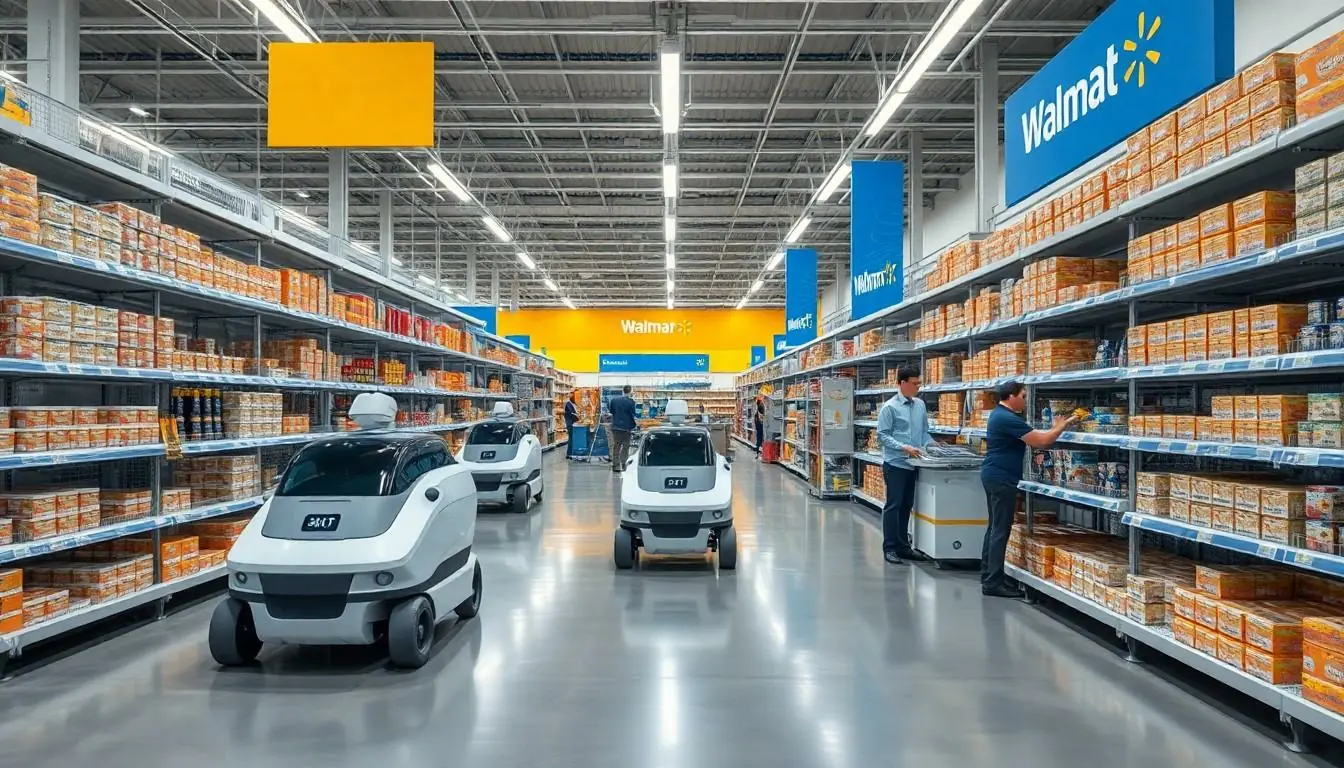Walmart isn’t just the place to score a great deal on toilet paper anymore; it’s becoming a tech powerhouse. With advanced systems and robotics taking center stage, the retail giant is transforming the shopping experience faster than you can say “rollback prices.” Imagine robots zipping through aisles, restocking shelves, and even guiding customers to the last pack of their favorite snacks.
Table of Contents
ToggleOverview of Walmart Advanced Systems and Robotics
Walmart embraces technology to enhance operational efficiency and customer service. Advanced systems manage store inventory with precision, reducing stock discrepancies. Robotics play a critical role in automating repetitive tasks. For instance, shelf-scanning robots check stock levels and identify misplaced items. This process boosts inventory accuracy and improves store organization.
Robots also streamline the restocking process. Employees can focus on high-value tasks while robots handle mundane chores. Automated guided vehicles navigate aisles to deliver products from warehouses to shelves. These innovations cut down on labor costs and increase overall productivity.
Additionally, Walmart employs sophisticated data analytics to refine these systems. Analyzing shopping patterns allows Walmart to optimize product placements and enhance the shopping experience. This adaptation responds quickly to shifts in consumer demand.
Walmart’s investment in robotics extends to customer assistance. Interactive kiosks and mobile apps help shoppers locate items efficiently. This technology connects customers with information, reducing the time spent searching.
The integration of these systems signifies a shift towards a modern retail landscape. Each advancement emphasizes Walmart’s commitment to leveraging technology for better service. As these systems evolve, Walmart remains at the forefront of the retail transformation.
Key Features of Advanced Systems

Walmart’s advanced systems leverage technology to streamline operations and enhance customer experiences. Key features include sophisticated automation and robotics that redefine efficiency in retail.
Automation in Inventory Management
Automation significantly transforms inventory management at Walmart. Smart systems automatically track stock levels, minimizing human error and reducing overhead costs. These systems utilize real-time data to forecast demand accurately, ensuring that popular items remain available. Regular inventory audits conducted by automated tools provide precise insights into product movement. Using this information, Walmart strategically restocks shelves, reducing the risk of stockouts and excess inventory. Improved accuracy in tracking contributes to better decision-making regarding pricing and promotions.
Robotics in Supply Chain Operations
Robotics play a crucial role in Walmart’s supply chain operations. Automated guided vehicles swiftly transport merchandise from warehouses to sales floors, minimizing transit times and improving delivery efficiency. Use of robotic systems for inventory scanning ensures consistent accuracy in tracking stock. Robotics also assist in sorting and organizing products, streamlining warehouse operations significantly. Staff members can focus on high-priority tasks rather than repetitive manual labor since robots handle lower-value activities. Integration of robotics enhances overall productivity and supports Walmart’s commitment to delivering superior customer service.
Benefits of Implementing Advanced Systems
Walmart’s advanced systems and robotics lead to significant benefits for the company. Enhanced operational capabilities boost overall performance.
Enhanced Efficiency and Productivity
Automation streamlines various tasks, allowing employees to redirect their focus to more critical responsibilities. Inventory management and restocking processes improve, reducing the time spent on repetitive activities. Robots handling shelf scanning and stock organization increase accuracy, reducing the risk of human error. This efficiency translates into faster service for customers, creating a more satisfying shopping experience. Additionally, data analytics provide insights into sales trends, enabling quick adjustments to inventory and maximizing product availability on store shelves.
Cost Reduction and Resource Optimization
Implementing advanced systems lowers overhead costs substantially. Automated guided vehicles replace manual labor for transporting products, reducing labor expenses. Smart inventory tracking minimizes stock loss, ensuring retailers keep popular items readily available. Regular audits conducted by automation eliminate excess stock and reduces waste. Walmart benefits from using technology to manage resources more effectively, ultimately achieving sustainable operational growth. These cost savings contribute directly to competitive pricing, enhancing the value proposition for consumers.
Challenges Faced by Walmart
Walmart encounters various challenges while implementing advanced systems and robotics. These obstacles require careful navigation to harness the full potential of the technology.
Integration with Existing Systems
Integrating new technologies with existing systems poses significant challenges. Disparate systems may not communicate seamlessly, hindering overall efficiency. Employees often face the learning curve associated with new platforms, which may disrupt productivity during transition periods. Ensuring compatibility with legacy systems affects data retrieval and management. Moreover, frequent updates and maintenance can strain IT resources, requiring dedicated teams. Businesses rely on consistent updates, making it crucial to align systems for greater efficiency.
Workforce Implications
The introduction of automation significantly impacts the workforce at Walmart. Employees may face job displacement anxiety due to increased reliance on robotics. Transitioning roles occurs as automation takes over repetitive tasks, allowing staff to engage in more value-driven opportunities. Training initiatives become necessary to equip employees with new skills relevant to high-tech environments. Additionally, adjusting workplace dynamics presents challenges in employee morale and collaboration. Balancing the use of advanced systems with retained human support ensures that Walmart maintains a positive workplace culture while adapting to technological changes.
Walmart’s integration of advanced systems and robotics marks a transformative step in the retail industry. By leveraging technology to enhance efficiency and customer service, Walmart not only streamlines operations but also creates a more satisfying shopping experience. The balance between automation and human support is vital for maintaining a positive workplace culture while adapting to new technologies.
As Walmart continues to innovate, it sets a standard for others in the retail sector. The commitment to improving operational efficiency through automation and data analytics reflects a forward-thinking approach that prioritizes both customer satisfaction and employee development. This evolution positions Walmart as a leader in the modern retail landscape, paving the way for future advancements in the industry.
